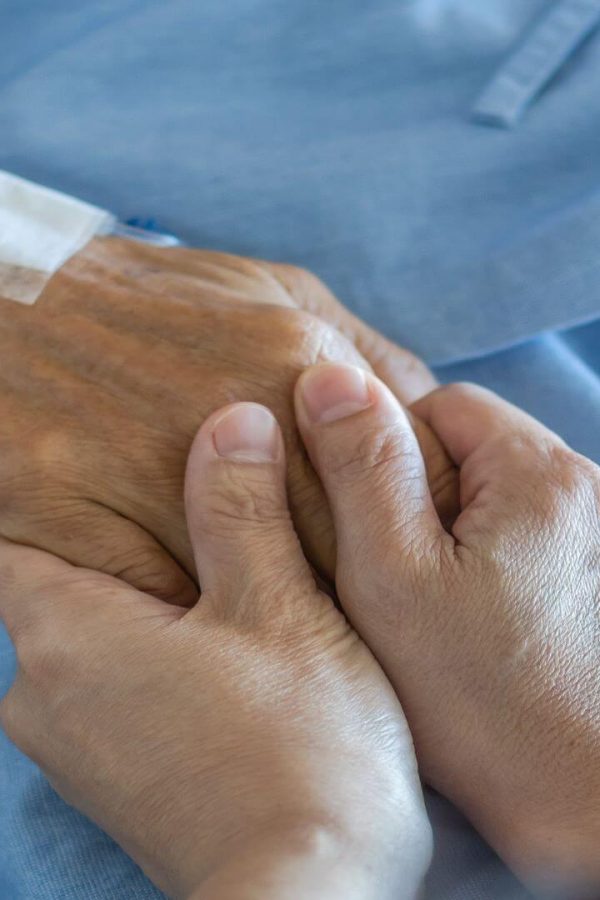Introduction
Modern medicine is divided into preventive, curative and palliative care. The procedures and attitudes in palliative medicine enable the patient and their family to cope with the diagnosis of incurable and terminal disease, and achieve the highest possible quality of life for all concerned.
The World Health Organization (WHO) defines palliative care as an approach that improves the quality of life of patients and their families facing the problem associated with life-threatening illness, through the prevention and relief of suffering by means of early identification and impeccable assessment and treatment of pain and other problems, physical, psychological and spiritual. The European Association for Palliative Care (EAPC) gives a somewhat different definition: Palliative care is the active total care of patients whose disease is not responsive to curative treatment. Control of pain, of other symptoms, and of psychological, social and spiritual problems is paramount. Palliative care is interdisciplinary in its approach and encompasses the patient, the family and the community in its scope. In a sense, palliative care is to offer the most basic concept of care – that of providing for the individual needs of the patient wherever he or she is cared for, either at home or in the hospital. Palliative care affirms life and regards dying as a normal process; it neither hastens nor postpones death. It sets out to preserve the best possible quality of life until death (1). Regardless of formal definitions, they all have in common the care for severely ill patients, and an attempt and effort to respond to the needs that are the source of suffering for the patients and the members of their family.
The fundamental constituents of a holistic approach to palliative care are: the control of pain and other symptoms, communication skills, psychological and spiritual support, complementary treatment, family education, the protection of family members and those providing care, care integration and coordination, and grief support. An important prerequisite for palliative care is a team and multidisciplinary approach (2).
Malignant disease patients are the most common users of palliative care, although it is also directed to patients with other severe, incurable diseases. Cancer is the second most significant cause of death in Croatia, responsible for the deaths of one in four. The five most common cancer sites in women are: breast (26%), colon (8%), trachea, bronchi and lungs (8%), uterus (6%) and thyroid (6%). The most common cancer sites in men are: trachea, bronchi and lungs (18%), prostate (18%), colon (9%), rectum, rectosigmoid and anus (7%) and bladder (6%) (3).
The most common symptom in palliative care patients is pain, followed by fatigue, anxiety, heavy breathing, nausea, constipation, loss of appetite, insomnia, dry mouth, problems with chewing and swallowing, etc. (4).
Constipation
Constipation is a subjective symptom that includes difficulties due to decreased frequency of bowel movement, and the stool being dry and hard. This is accompanied by distension, bloating, cramping or a rectum filled with stool (2).
Constipation is very common in palliative care, and causes suffering to the patient. The prevalence of constipation in patients with different advanced diseases is 25-50% (4). Patients with spinal cord injury suffer from constipation in 95% of cases, patients with multiple sclerosis in 40% of cases, and patients with spina bifida in 79% of cases (5).
There are different causes of constipation in palliative care, ranging from those present in the patient even before the occurrence of the incurable disease, to those that are directly affected by the disease itself, and due to the curative treatment that is being provided. For example, the long-term use of laxatives before the incurable disease, neuropathy (with diabetics), dehydration, hypercalcemia, a reduced intake of food rich in fibre and fluid, usage of opioids in pain treatment, weakened bowel motility and thus the impossibility of independent defecation, certain psychological barriers, a lack of understanding among those around the patient, and other psychological factors (4, 6, 7).
The most common causes of constipation in the advanced stages of various diseases, and so in palliative care patients, are shown in Table 1.
Table 1 Organ-related and functional factors related to constipation in advanced diseases (8)
| Medication | Opioid analgesics, sedatives, antitussives, anticholinergics, antiemetics, neuroleptics, iron, diuretics, chemotherapeutics |
| Metabolic problems | Dehydration, hypercalcemia, hypocalcemia, uremia, diabetes, hypothyroidism |
| Neuromuscular disorders | Myopathy |
| Neurological disorders | Autonomic disfunction, spinal or cerebral tumours, anything in which the spinal cord is affected |
| Structural problems | Growths in the abdomen or pelvis, post- radiation fibrosis, peritoneal carcinomatosis |
| Pain | Cancer pain, chest pain, anorectal pain |
| Diet | Reduced intake of fibre, anorexia, insufficient food and fluid intake |
| Environmental factors | Lack of privacy, need for support during defecation or urination, cultural matters |
| Other factors | Physical inactivity, age, depression, sedation |
The treatment of palliative care patients very often includes medication that causes constipation. Table 2 shows the medications that most frequently cause constipation, and recommendations on what to do in such cases and how to help the patient.
Table 2 (9)
| Medication causing constipation | Possible solution |
|---|---|
| Antihypertensives (calcium channel blockers, clonidine) | Changing antihypertensives (e.g. ACE inhibitors, beta blockers |
| Tricyclic antidepressants | SSRI (selective serotonin reuptake inhibitors) |
| Iron preparations | Use of iron preparations IM or IV or use of laxatives |
| Antiepileptics | Use of laxatives |
| Opioid analgesics | Combination of oxycodone with naloxone or methylnaltrexone, opioid rotation, laxatives |
| Antiparkinson drugs (anticholinergics or dopaminergics) | Use of laxatives |
With regard to palliative care, family doctors most often see cancer patients whose most common cause of constipation is the use of opioids in pain treatment. The incidence of constipation due to opioid use is 40-60%, depending on opioid dosage and type (8). Constipation among cancer patients is caused by chemotherapeutics, sedatives, anticholinergics and excessive use of laxatives. Environmental factors like the impossibility of independent toilet use, lack of privacy and/or use of adult diapers.

Diagnosis of constipation in palliative care patients
As with any other problem, the patient’s medical history is the basis of diagnosis. Physical examination will identify the presence or absence of peristalsis, presence of bowel gases or abdominal distension. With regard to cancer patients we can use one of the scales developed to assess constipation, of which the Bristol Stool Chart is most commonly applied, and we can also use the Victoria Bowel Performance Scale and Constipation Assessment Scale (8). Still, the most important stages in diagnosis are gathering the medical history and physical examination.
Table 3 The basic physical examination with suspicion of constipation, and recommendations for the focus of attention during the examination (8)
| Abdominal examination | Inspection of the perianal region | Digitorectal examination |
|---|---|---|
| Distension | Skin changes | Internal haemorrhoids |
| Abdominal formation | Fissures | Sphincter tonus |
| Enlarged liver | Prolapses | Softness |
| Abdominal softness under palpation | Anal warts | Obstruction/stenosis |
| Increased/lowered auscultatory phenomena in abdominal auscultation | Perianal ulcerations | Faecal impaction |
| No stool | ||
| Tumour mass | ||
| Blood |
Recommendations of the European Society of Medical Oncology (ESMO) for the assessment of cancer patients (8):
- A constipation assessment is required with all cancer patients.
- The assessment should include a detailed medical history in order to detect the possible causes of constipation.
- The use of constipation assessment scales is recommended.
- Should the medical history confirm constipation, the physical examination should include abdominal palpation, inspection of the perianal region and digitorectal examination.
- Routine examinations are not required.
- In cases of clinical suspicion, the serum calcium level and thyroid function should be checked. An extensive analysis is required with patients with a sudden change in consistency or with the occurrence of blood in their stool.
- A native abdominal x-ray has limited value, and can serve only for the estimation of faecal content and exclusion of bowel obstruction.
Prevention and treatment of constipation in palliative care
General measures in the prevention and treatment of constipation apply to palliative care patients. Patients are advised to follow the appropriate diet rich in raw fruit and vegetables, with additional intake of fibre and sufficient fluid. Should the patient’s state allow it, it is necessary to provide privacy for defecation and urination, and to avoid that these take play in the lying position, in bed. The use of laxative preparations made from dried plums, figs and grapes is recommended. Should all these measures fail, then laxative treatment that is individually adjusted to the needs of each patient is recommended, and the therapy must be on a continuous basis and in the appropriate dosage (2, 8, 10). When prescribing laxatives, it is important to take into consideration other types of therapy, especially with oncological treatment, in order to avoid interactions.
In palliative care, one of the most common causes of constipation is opioid usage. This is why such patients are recommended the following interventions (8):
- If it is not contraindicated due to previous diarrhoea, all patients taking opioid analgesics in therapy should also have an accompanying laxative.
- Osmotic or stimulating laxatives are recommended.
- The consumption of fibres such as psyllium is not recommended.
- Should constipation persist regardless of the measures outlined above, methylnaltrexone or naloxegol could be taken into consideration.
- A combination of opioids and naltrexones has proven to be efficient in reducing the risk of constipation due to opioid use.
- Special attention should be given to elderly cancer patients.
- For the purposes of prevention, it is important that these patients are:
– ensured access to a toilet and/or given privacy during defecation and urination
– given dieting advice
– paid attention to with respect to the possible decreased intake of food and fluids, as this can that negatively affects stool frequency, consistency and volume
– prompted to defecate and urinate (educate such patients to try to defecate at least twice a day, 30 minutes after a meal, with no more than 5 minutes of straining). - Laxative use should be individualized and adapted to each patient, depending on the comorbidities and other therapies the patient is undergoing.
- Regular supervision of patients with chronic kidney or heart failure treated with diuretics or cardiac glycosides (due to the risk of dehydration and unbalanced electrolytes).
- PEG provides an efficient and tolerable solution for elderly patients (with a good safety profile) to control the intake of food and fluids.
- The use of paraffin oil should be avoided for recumbent, immobile patients and those with swallowing problems (due to the risk of aspiration pneumonia).
- Salt-based laxatives (e.g. magnesium hydroxide) are not recommended, as there has still been no research on their safe application with elderly patients.
- In cases of swallowing problems or continuous faecal impaction, rectal measures (enemas and suppositories) can be the preferred treatment. Isotonic physiological enemas are advisable with elderly patients.
Special attention should be given to elderly cancer patients. The European Society of Medical Oncology (ESMO) recommends the following (8):
Conclusion
Palliative care is an important part of a family doctor’s work. Through provision of different measures of prevention and treatment, and by offering psychological and spiritual support, family doctors are focused on pain relief and maintaining the life quality of patients with severe, incurable diseases, and that of their family members. Constipation is one of the common problems that family doctors face in palliative care, one that can greatly reduce the patient’s quality of life. Timely recognition of the problem and the use of an individual approach to each patient are the keys to resolving the issue of constipation, and the continuous education of physicians contributes to better quality in the provision of palliative care to patients.
References
- Braš M, Đorđević V, Kandić- Splavski B, Vučevac V. Osnovni pojmovi o palijativnoj medicini i palijativnoj skrbi. Medix, april 2016, let. XXII, št. 119/120; str. 69–76.
- Katić M, Kašuba Lazić Đ, Soldo D. Palijativna skrb bolesnika s rakom probavnog sustava u obiteljskoj medicini. Acta Med Croatica, 69 (2015) 233–244.
- Hrvatski zavod za javno zdravstvo; Registar za rak Republike Hrvatske. Incidencija raka u Hrvatskoj 2015. Zagreb, 2018. Bilten št. 40.
- Miličić D, Kes P, Juretić A in sod. Zbrinjavanje najčešćih simptoma u palijativnoj medicini. Medix, april 2016., let. XXII, št. 119/120; str. 101–111.
- Krogh K, Chiarioni G, Whitehead W. Management of chronic constipation in adults. United European Gastroenterology Journal 2017, Vol. 5(4) 465–472.
- World Gastroenterology Organisation Global Guidelines, Constipation: a global perspective, november 2010
- Dzierżanowski T, Ciałkowska-Rysz A. Behavioral risk factors of constipation in palliative care patients. Support Care Cancer (2015) 23:1787–1793.
- Larkin P.J.,Cherny N.I.,La Carpia D, Guglielmo M, Ostgathe C, Scotte F, Ripamonti C.I, on behalf of the ESMO Guidelines Committee. Diagnosis, assessment and management of constipation in advanced cancer: ESMO Clinical Practice Guidelines. Annals of Oncology 29 (Supplement 4): iv111–iv125, 2018.
- Müller-Lissner S. The Pathophysiology, Diagnosis, and Treatment of Constipation. Dtsch Arztebl Int 2009; 106(25): 424–32.
- Hsieh C. Treatment of Constipation in Older Adults. Am Fam Physician. 15. sep. 2015; 92(6):500-504.
Choose chapter:






